| Article ID | Journal | Published Year | Pages | File Type |
|---|---|---|---|---|
| 5461173 | Journal of Alloys and Compounds | 2017 | 29 Pages |
Abstract
Tetrahedrite offers advantages over state-of-the-art thermoelectrics, such as lead telluride, because of its low cost and environmentally friendly composition. However, typical sealed-tube synthesis of tetrahedrite can require multiple days or weeks. In this study, tetrahedrite co-doped with nickel and zinc was synthesized by two different approaches which both require significantly less time than the conventional furnace-ampoule technique. The first technique utilizes a short ball milling step followed by reactive spark plasma sintering to form tetrahedrite, and the entire process requires less than 2 h of total synthesis time. The second method involves mechanical alloying to obtain single-phase tetrahedrite, combined with spark plasma sintering (SPS) for densification. Thermoelectric properties were measured and compared for samples of composition Cu10Ni2-xZnxSb4S13 (x = 0, 0.5, 1, 1.5) made by both techniques. Peak ZT values were obtained for Cu10Ni2Sb4S13 with ZT = 0.66 at 673 K for SPS reacted and mechanically alloyed samples. Transport properties are comparable between the two techniques, and this provides evidence that supports reactive spark plasma sintering as a viable synthetic technique for tetrahedrite thermoelectric materials.
Related Topics
Physical Sciences and Engineering
Materials Science
Metals and Alloys
Authors
Daniel P. Weller, Donald T. Morelli,
